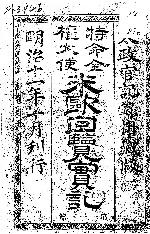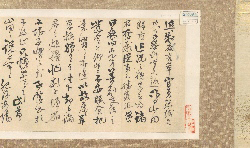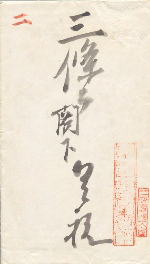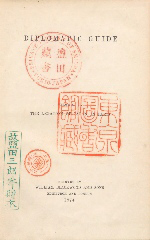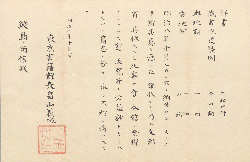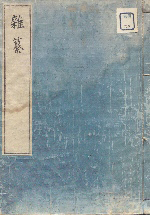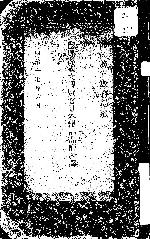![]()
Section 3: Meiji Government contact with France
Japanese of the Meiji Era experienced France in a variety of ways, including as students overseas or diplomats, or by participating in the government controlled Iwakura Mission. From among the students who were sent abroad immediately following the Meiji Restoration, a large number of diverse individuals appeared, including NAKAE Chomin (1847-1901) who was influential in the Freedom and People's Rights Movement, SAIONJI Kimmochi (1849-1940) who was long involved in politics as one of the original elders, and MAEDA Masana (1850-1921), who worked to increase production and promote industry as the Minister of Agriculture and Commerce. The Iwakura Mission was also unable to achieve the revision of the unequal treaties, but saw Paris, the City of Flowers, with their own eyes and left numerous detailed reports related to French industry and other topics.
Through the efforts of SAMESHIMA Naonobu (1845-1880), the first minister to France, and others, a systematic understanding was achieved of modern diplomacy rules which had not been known in Japan up until that point, and a foundation for diplomatic activities was constructed thereafter. In addition, the minister to France also played a major role when hiring foreigners.
The Iwakura Mission
KUME Kunitake (Ed.), Tokumei zenken taishi bei? kairan jikki, Hakubunsha, 1878 [34-88] 
This text is a report from the Iwakura Mission which departed on an inspection tour of various western countries in November of 1871. The author, KUME Kunitake (1839-1931), was a scholar of Chinese studies from the Saga Domain, participated in the mission as an attache, and focused on the editing of this text after returning in September of 1873. Widely publicizing the dispatch of the mission and the knowledge gained, was done based on the suggestion of the hired foreigner Guido Herman Fridolin Verbeck (1830-1898). The mission visited a number of countries, starting in the United States and succeeding Britain, France, Germany and Russia, and this text, which records in detail writings and copperplate prints about each country, was considered an encyclopedic work. Regarding France, the work records information in brief, but from a wide variety of fields, including industrial facilities like the Manufacture nationale de Sevres and bread factories, to cultural facilities such as the Bibliotheque nationale de France, to welfare facilities such as schools for the blind. The section of review articles on each country notes, "France is the country in which civilization is most advanced in Europe, with a variety of products distributed and is an origin point for fashions and styles."
IT? Hirobumi shokan [Papers of INOUE Kaoru, #279‐3] 
This letter was sent from ITO Hirobumi (1841-1909), who served as deputy envoy to the Iwakura Mission, to INOUE Kaoru (1835-1915), who served as the vice-minister of finance for the temporary government. The letter was written a little more than 40 days after the arrival in France, however there are no particular references to observations or experiences within France, differing greatly from KUME's Bei? kairan jikki. The purpose of the mission was not only to survey of US and European systems, but also to carry out diplomatic negotiations on the revision of the unequal treaties. These materials are from the point at which negotiations had been carried out with the US, Britain and France, and show that of the freedom of religious faith and freedom of movement of foreigners within Japan, ITO saw the latter as an issue of concern to Japan.
IWAKURA Tomomi shokan [Papers of SANJO Famille (Letters), #191-41, #191-44] 
These materials are letters from IWAKURA Tomomi (1825-1883), who was ambassador extraordinary and plenipotentiary to the mission, to Grand Minister of State SANJO Sanetomi (1837-1891), who was the chief executive of the temporary government. The first letter is dated December 20, 1872 and it reports that the mission has departed Britain and safely arrived in France. The 2nd letter is dated January 20, 1873, at a point when the mission had already exceeded its planned trip overseas, and reports that the missions return could not be sped up and that KIDO Takayoshi (1833-1877) and OKUBO Toshimichi (1830-1878) could not return early ahead of the rest of the mission without any special pretext. In addition to the letters introduced here, there were also letters frequently sent by IWAKURA to SANJO from the mission's departure in November 1871 onward, providing a view of the decision making process between the mission and the temporary government.
SAMESHIMA Naonobu, the first minister to France
Japanese Legation in Paris, Diplomatic guide, Edinburgh, London, 1874 [I-12] 
SAMESHIMA Naonobu, who later became the first minister to France was dispatched in October 1870 and died in France in December of 1880. This text was created in the course of SAMESHIMA carrying out duties as a diplomat, such as hiring Georges Hilaire Bousquet (1846-1937) and Gustave Emile Boissonade (1825-1910) and providing facilities to the Iwakura Mission. After arriving in Paris, together with British attorney Frederic Marshall (1839-1905), who was hired as a secretary and clerk to assist with diplomatic duties, SAMESHIMA compiled basic knowledge on European diplomatic customs and foreign affairs, and published it under the name of the Japanese Legation in Paris for successive Japanese diplomats. Only 200 copies of this text were published, so it was not made generally available. The copy held by the NDL was donated by SHIODA Saburo (1843-1889), who was a diplomat involved in the negotiations for the revision of the unequal treaties.
T?ky? shojakukan e eifutsusho kiz? no ken [Papers of SAMESHIMA Naonobu & Takenosuke (Deposit), #82] 
Some of the collection of books of SAMESHIMA, who died in Paris, were sold or donated to the Tokyo Shojaku-kan/Tokyo Library, which were the predecessors of the National Diet Library, and still remain in the collections today. These materials are letters of thanks for donated works. Some of the works were donated by SAMESHIMA himself when he temporarily returned to Japan for convalescence, and some by his youngest brother Sakari (1851-1903) after his death. Togather with works which was purchased by the Tokyo Shojaku-kan, the total number is more than 520 works. The majority of these texts were in English or French, including dedicated copies from Marshall who cooperated in the editing of the Diplomatic Guide and Boissonade.
1878 Paris exposition
Futsukoku hakurankai jimukyoku, Furansu Parifu bankoku daihakurankai h?kokusho, Futsukoku hakurankai jimukyoku, 1880 [35-36] 
This is a report that the government secretariat at the time of participation in the 1878 Paris International Exposition created after the completion of the exhibition. This was the third time the post Meiji Restoration Japanese government participated in the International Exhibition after Vienna (1873) and Philadelphia (1876), and it seemed that the secretariat felt that this occasion garnered the best response to date. This report contains the overall outline of the exhibition, the secretariats work, the assessment of Japanese products and a list of Japanese product award winners, the exhibition of other countries' products and other information. A large number of pages are dedicated to discussing Japanese product awards and important points, with a large amount of content on ceramics, silk, leather, grains, meats, fish, and drinks, in particular. More detail can be found on the products exhibited by award winners in the "1878 France International Exhibition Exhibit Table" created by the secretariat.
[Daihakurankai ik? Pari fuka Nihon buppin juy? henka nitsuki h?koku] [Papers of MAEDA Masana, #284] 
MAEDA Masana travelled to France in 1869 to study abroad, and stayed in Paris until 1876, and worked to increase production and promote industry for the Ministry of Agriculture and Commerce after returning to Japan. On the occasion of the 1878 Paris exposition, he participated as the secretary general of the Paris International Exposition and went to Paris ahead of vice president MATSUKATA Masayoshi (1835-1924), and remained in Paris after the end of the expo to carry out remaining duties. These materials are his descriptions of people's attitudes towards Japan and his views on those attitudes. He expresses regret that while there was increasing interest and appeal in Japan in Paris after the expo, there was no literature or other materials to provide in response to this interest, that there was not a generally favorable view of Japanese merchants in Paris, and that there was no way available to take advantage of the interest in Japan and link it to exports. These materials were collected in a booklet titled "Zassan (lit. Varia)", and successive parts include the script for the play "Nippon bidan (lit. Japanese moving tale)" (an adaptation of "Ch?shingura"), which was written by MAEDA in French and performed at the expo to favorable response.
ONO Kiyoteru (Tr.), Pari bankoku daihakurankai Nihon shuppin hinpy? sh?yaku, N?sh?mush? shomukyoku, 1885 [22-267] 
This is an abridged translation of French comments on products exhibited at the 1878 Paris exposition. There are also translations for industries which are not directly related, such as the "wool and blanket section" for which there is no evaluation of Japanese products. For evaluations of Japanese products, high appraisals of ceramics and Japanese leather paper stand out, noting, "the Japanese leather paper exhibited was one of the most serviceable from among those exhibited by other countries". The translator, ONO Kiyoteru (1851-1924) worked at the Ministry of Agriculture and Commerce after working in the Artillery Bureau of the Ministry of the Army. He also translated Maurice Block's "Traite theorique et pratique de statistique" [36-117] and the "Futsukoku n?mu enkakushi (lit. History of French Agriculture)" [MAEDA Masana papers 260], which can be thought to have been used as working materials.

